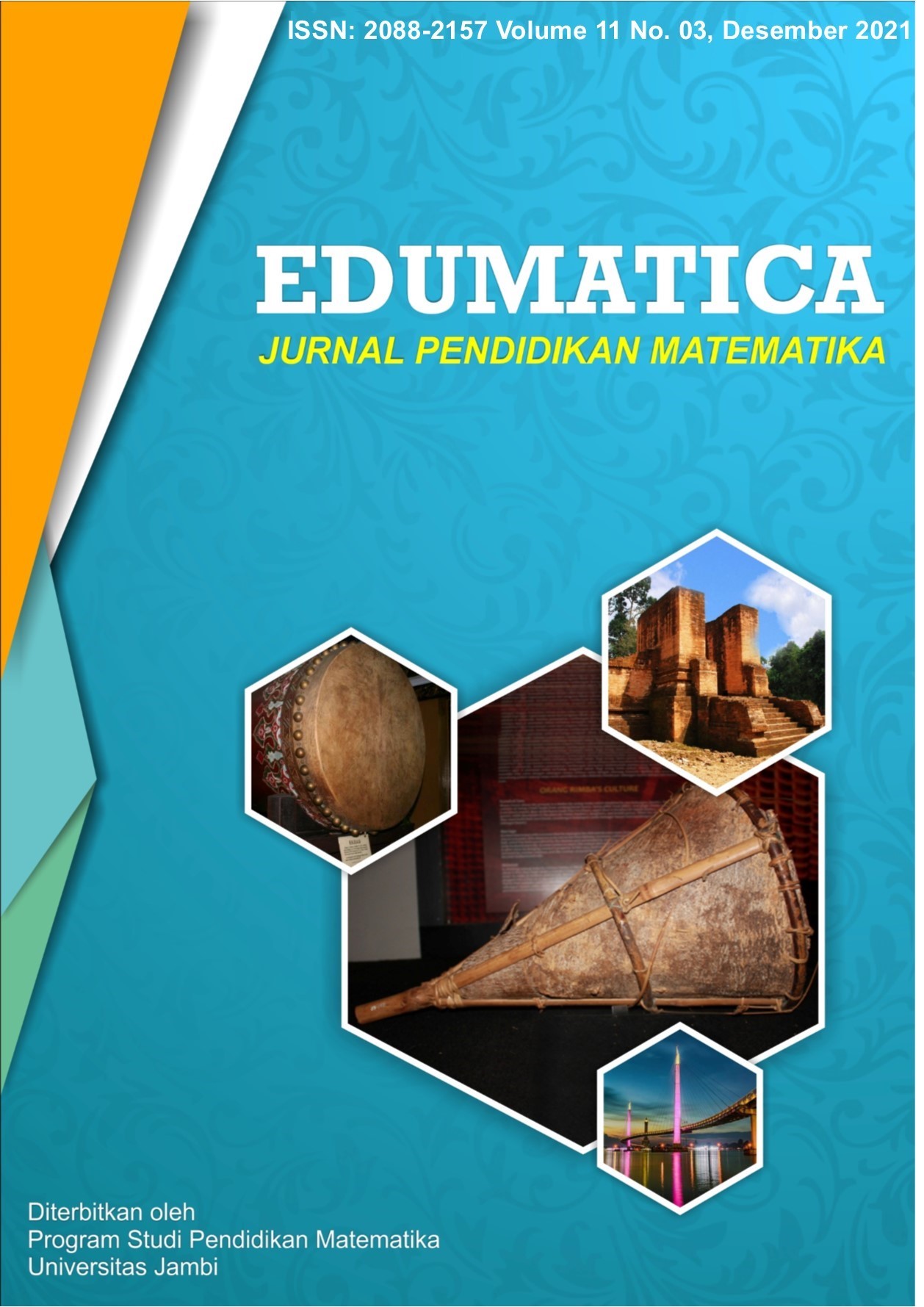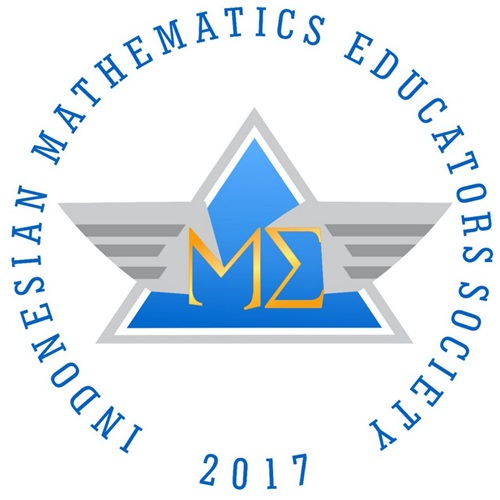Developing e-module of the Non-linear Equation based on constructivism approach with a Microsoft Excel-assisted
DOI:
https://doi.org/10.22437/edumatica.v11i03.13746Keywords:
constructivism approach, microsoft excel, non-linear equationsAbstract
This study aims to produce a valid and practical e-module of the Non-linear Equation with a Microsoft Excel-assisted constructivism approach for students. This research is development research using the ADDIE (Analysis, Design, Development, Implementation, and Evaluation) development model. Data in this study were collected through questionnaires, documentation, and interviews. Data in this study were analyzed descriptively qualitatively and quantitatively. The result of this research is that the e-module of the Non-linear Equation with a Microsoft Excel-assisted constructivism approach is valid and feasible for students. The validity of the e-module is seen from the results of experts' assessments of the material and media used in the e-module. The overall e-module validity score was 83.5%. The feasible of e-module can be seen from the results of student responses who use e-module in learning the Non-linear Equation. The result of student response is 90.16% with a very good practicality category. Based on the results and data analysis, it can be concluded that the developed e-module is valid and feasible so that it can be used in learning the Non-liniear Equation.
Downloads
References
Abidin, Z., & Walida, S. El. (2017). Pengembangan E-modul Interaktif Berbasis CASE (Creative, Active, Systematic, Effective) sebagai Alternatif Media Pembelajaran Geometri Transformasi untuk Mendukung Kemandirian Belajar dan Kompetensi Mahasiswa. Seminar Nasional Matematika dan Aplikasinya, 197-202. http://matematika.fst.unair.ac.id/wp-content/uploads/2019/03/29-Zainal-Abidin__Pendidikan_.pdf
Adaira, D., & Jaegerb, M. (2018). Constructive Learning Applied to The Teaching of Numerical Methods for Engineers. Proceedings of 3rdAnnual Project Based Learning (PBL) Symposium, ACK, Mishref,Kuwait, March, 2018. https://www.researchgate.net/profile/D_Adair/publication/323627859_Constructive_Learning_Applied_to_the_Teaching_of_Numerical_Methods_for_Engineers/links/5ac5a511a6fdcc051daf3045/Constructive-Learning-Applied-to-the-Teaching-of-Numerical-Methods-for-Engin
Anderson, L. W., & Krathwohl, D. R. (2001). Bloom’s Taxonomy of Learning Objectives : Cognitive Domain. In A taxonomy of learning, teaching and assessing: a revision of Bloom’s Taxonomy of educational objectives. Longman.
Asminah, & Sahfitri, V. (2012). Implementasi dan Analisis Tingkat Akurasi Software Penyelesaian Persamaan Non Linier dengan Metode Fixed Point Iteration dan Metode Bisection. Seminar Nasional Informatika 2012 (SemnasIF 2012), 2012(semnasIF), 1-8.
Bernard, M., & Senjayawati, E. (2019). Developing the Students’ Ability in Understanding Mathematics and Self-confidence with VBA for Excel. JRAMathEdu (Journal of Research and Advances in Mathematics Education), 1(1), 45-56. https://doi.org/10.23917/jramathedu.v1i1.6349
Djamila, H. (2017). Excel Spreadsheet in Teaching Numerical Methods. Journal of Physics: Conference Series, 890(1), 12093.
Drier, H. S. (2001). Teaching and Learning Mathematics with Interactive Spreadsheets. School Science and Mathematics, 101(4), 170-179.
Fernandez, S., Orosa, J. A., & Galan, J. J. (2012). A New Methodology to Teach Numerical Methods with MS Excel. Journal of Maritime Research, 9(2), 29-32.
Fitriani, N., Suryadi, D., & Darhim, D. (2018). The Students’ Mathematical Abstraction Ability Through Realistic Mathematics Education with VBA-Microsoft Excel. Infinity Journal, 7(2), 123. https://doi.org/10.22460/infinity.v7i2.p123-132
Fonda, A., & Sumargiyani, S. (2018). The Developing Math Electronic Module with Scientific Approach Using Kvisoft Flipbook Maker Pro for XI Grade of Senior High School Students. Infinity Journal, 7(2), 109-122. https://doi.org/10.22460/infinity.v7i2.p109-122
Handayani, A. D., Herman, T., & Fatimah, S. (2017). Developing Teaching Material Software Assisted for Numerical Methods. Journal of Physics: Conference Series, 895(1), 0-6. https://doi.org/10.1088/1742-6596/895/1/012019
Hidayatulloh, M. S. (2003). Pengembangan E- Modul Matematika Berbasis Problem Based Learning Berbantuan Geogebra. Pendidikan Matematika FPMIPA Universitas PGRI Semarang, 1(2), 24-31.
Kamodi, T. ., & Garegae, K. . (2019). Teachers’ Perceptions on Use of Microsoft Excel in Teaching and Learning of Selected Concepts in Junior Secondary School Mathematics Syllabus in Bostwana. Lonaka Journal of Learning and Teaching, 10(1), 67-81. https://journals.ub.bw/index.php/jolt/article/view/1550
Keane, G., Carr, M., & Carroll, P. (2008). An Integrated Approach to the Teaching of Numerical Methods to Engineering Students. 2nd International Technology, Education and Development Conference.
Khaidir, C. (2016). Pengembangan Buku Ajar Metode Numerik Berbasis Konstruktivisme di IAIN Batusangkar. Ta’dib, 19(1), 67-82. https://doi.org/10.31958/jt.v19i1.452
Khaidir, C. (2019). Efektivitas Buku Ajar Metode Numerik Berbasis Konstruktivisme di IAIN Batusangkar. Jurnal Saintika Unpam : Jurnal Sains Dan Matematika Unpam, 2(2), 109-114. https://doi.org/10.32493/jsmu.v2i2.3321
Kuka, S., & Karamani, B. (2011). Using Excel and VBA for Excel to Learn Numerical Methods. 1st International Sympsosium on Computing in Informatics and Mathematics, Iscim, 365-376.
Nasution, M. D., Nasution, E., & Haryati, F. (2017). Pengembangan Bahan Ajar Metode Numerik dengan Pendekatan Metakognitif Berbantuan Matlab. Mosharafa: Jurnal Pendidikan Matematika, 6(1), 69-80. https://doi.org/10.31980/mosharafa.v6i1.295
Nurjamil, D., & Apiati, V. (2015). Penerapan Pendekatan Open-Ended Berbantuan Program Microsoft Excel dalam Pembelajaran Matematika untuk Meningkatkan Kemampuan Berpikir Kreatif Matematik Peserta Didik. JP3M (Jurnal Penelitian Pendidikan Dan Pengajaran Matematika), 1(1), 7-12.
Oktaviara, R. A., & Pahlevi, T. (2019). Pengembangan E-modul Berbantuan Kvisoft Flipbook Maker Berbasis Pendekatan Saintifik pada Materi Menerapkan Pengoperasian Aplikasi Pengolah Kata Kelas X OTKP 3 SMKN 2 Blitar Rhesta Ayu Oktaviara Triesninda Pahlevi. Jurnal Pendidikan Perkantoran.
Othman, Z. S. B., Khalid, A. K. Bin, & Mahat, A. B. (2018). Students’ Common Mistakes in Basic Differentiation Topics. AIP Conference Proceedings, 1974(1), 50009.
Pratiwi, R. W., & Oktavinora, R. (2017). Practicality of Numerical Method Workbook Based on Constructivism in FKIP UMMY Solok. 2nd International Seminar on Education 2017 Empowering Local Wisdom on Education for Global Issue, 333-338. http://ecampus.iainbatusangkar.ac.id/ojs/index.php/proceedings/article/view/886
Pudar-Hozo, S. (2015). Excel Spreadsheet Manual for Applied Mathematics (Vol. 17, Issue 3). Pearson. http://mcours.net/cours/pdf/info1/Excel_spreadsheet_manuel_dfrte.pdf
Pujiastuti, H., Haryadi, R., & Arifin, A. M. (2020). The development of Augmented Reality-Based Learning Media to Improve Students’ Ability to Understand Mathematics Concept. Unnes Journal of Mathematics Education, 9(2), 92-101. https://doi.org/10.15294/ujme.v9i2.39340%0A
Rikayanti, R. (2017). Pengembangan Bahan Ajar Berbasis Software Matlab pada Mata Kuliah Metode Numerik. Symmetry: Pasundan Journal of Research in Mathematics Learning and Education, 2(2), 18-30.
Ritonga, J., & Suryana, D. (2019). Perbandingan Kecepatan Konvergensi Akar Persamaan Non Linier Metode Titik Tetap dengan Metode Newton Raphson Menggunakan Matlab. INFORMASI (Jurnal Informatika Dan Sistem Informasi), 11(2), 51-64. https://doi.org/10.37424/informasi.v11i2.17
Riyadi, S., & Qamar, K. (2017). Efektivitas E-modul Analisis Real pada Program Studi Pendidikan Matematika Universitas Kanjuruhan Malang. Supremum Journal of Mathematics Education (SJME) Journal, 1(1), 26-33.
Setialesmana, D. (2016). Pengaruh Penggunaan Pendekatan Konstruktivisme terhadap Kemampuan Berpikir Kritis Matematik Mahasiswa. JP3M (Jurnal Penelitian Pendidikan Dan Pengajaran Matematika), 2(2), 99-106.
Siregar, M. K., & Yenti, F. (2018). Pengembangan Bahan Ajar Mata Kuliah Matematika Diskrit Berbasis Konstruktivisme. PYTHAGORAS: Jurnal Program Studi Pendidikan Matematika, 7(2), 85-94. https://doi.org/10.33373/pythagoras.v7i2.1461
Suarsana, I. M., & Mahayukti, G. A. (2013). Pengembangan E-Modul Berorientasi Pemecahan Masalah untuk Meningkatkan Keterampilan Berpikir Kritis Mahasiswa. Jurnal Nasional Pendidikan Teknik Informatika (JANAPATI), 2(3), 193. https://doi.org/10.23887/janapati.v2i3.9800
Sunandar, E., & Indrianto, I. (2020). Perbandingan Metode Newton-Raphson & Metode Secant Untuk Mencari Akar Persamaan dalam Sistem Persamaan Non-Linier. Petir, 13(1), 72-79. https://doi.org/10.33322/petir.v13i1.893
Sutawidjaja, A., & Afgani, D. J. (2015). Konsep Dasar Pembelajaran Matematika. In repository.ut.ac.id. http://repository.ut.ac.id/4377/1/MPMT5301-M1.pdf
Sutrisno, A., Purnomo, J., & Margono. (2015). Pemanfaatan Aplikasi MS Excel untuk Pembelajaran Matematika. Direktorat Jenderal Guru dan Tenaga Kependidikan Kementerian Pendidikan dan Kebudayaan. http://repositori.kemdikbud.go.id/15169/1/MS-Excel.pdf
Yahya, Y., & Nur, A. M. (2018). Pengaruh Aplikasi C# dalam Proses Perhitungan Numerik Terhadap Solusi Persamaan Non Linier. Infotek : Jurnal Informatika Dan Teknologi, 1(2), 79-87. https://doi.org/10.29408/jit.v1i2.901
Downloads
Published
How to Cite
Issue
Section
License
Copyright (c) 2021 Putri Fitriasari, Yunika Lestaria Ningsih

This work is licensed under a Creative Commons Attribution-NonCommercial-ShareAlike 4.0 International License.







